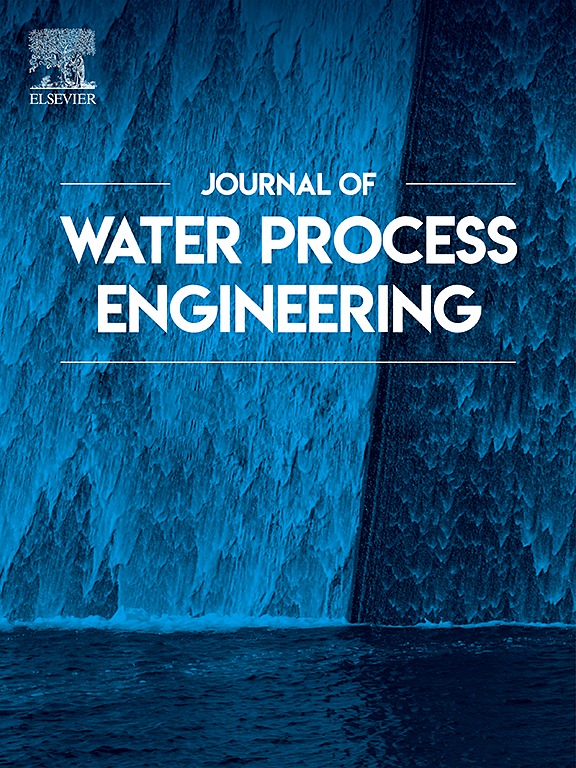替代性二元绿色氧化剂在膜生物反应器渗滤液出水环保化处理中的应用
IF 6.3
2区 工程技术
Q1 ENGINEERING, CHEMICAL
引用次数: 0
摘要
采用CaO2/PS/Fe(II)和CaO2/PMS/Fe(II)工艺研究了膜生物反应器(MBR)出水的可处理性。虽然现有的研究主要集中在合成废水上,但本研究评估了CaO2/PS/Fe(II)和CaO2/PMS/Fe(II)工艺对实际渗滤液MBR出水的影响。该研究将突出在处理中使用绿色氧化剂和催化剂的潜力。使用环境友好型氧化剂(CaO2、PS和PMS)和环境友好型催化剂(Fe(II)), Fe(II)因其具有低成本、丰度、低毒和可持续性等特性而被定义为环境友好型。二元工艺的COD去除率高于单一工艺,组合工艺的COD去除率最高。采用Box-Behnken设计(BBD)确定工艺变量对组合工艺的影响。CaO2/PS/Fe(II)的最佳初始条件为pH 6.92、Fe(II)剂量2.72 g/L、CaO2剂量3.65 g/L、PS剂量3.89 g/L; CaO2/PMS/Fe(II)的最佳初始条件为pH 7.22、Fe(II)剂量2.74 g/L、CaO2剂量3.37 g/L、PMS剂量4.65 g/L。在最佳工艺条件下,CaO2/PS/Fe(II)的COD去除率为89.5%,UV254去除率为98.9%,CaO2/PMS/Fe(II)的去除率为92.7%,UV254去除率为99.7%。为验证实验结果,CaO2/PS/Fe(II)的COD去除率为87.5%,UV254去除率为96.2%,CaO2/PMS/Fe(II)的去除率为90.1%,UV254去除率为97.6%。预测结果和实验结果之间的微小偏差(< 3%)归因于废水异质性和实验边际。组合绿色氧化工艺有效地处理了符合接收介质排放标准的渗滤液MBR出水。本文章由计算机程序翻译,如有差异,请以英文原文为准。
Alternative binary green oxidant application for environmentally friendly treatment of leachate membrane bioreactor effluent
In this study, the treatability of leachate membrane bioreactor (MBR) effluent was investigated by CaO2/PS/Fe(II) and CaO2/PMS/Fe(II) processes. While existing studies focus on synthetic wastewater, this work evaluates CaO2/PS/Fe(II) and CaO2/PMS/Fe(II) processes for real leachate MBR effluent. The study will highlight the potential of using green oxidants and catalysts in the treatment. Environmentally friendly oxidants (CaO2, PS, and PMS) and environmentally friendly catalysts (Fe(II), which is defined as environmentally friendly with its properties such as low cost, abundance, low toxicity, and sustainability) were used. The COD removal efficiencies of binary processes were higher than those of single processes, and the highest COD removal efficiencies were achieved with combined processes. Box-Behnken Design (BBD) was applied to determine the effects of process variables on the combined processes. The optimum conditions were initial pH 6.92, Fe(II) dose 2.72 g/L, CaO2 dose 3.65 g/L, and PS dose 3.89 g/L for CaO2/PS/Fe(II) while initial pH 7.22, Fe(II) dose 2.74 g/L, CaO2 dose 3.37 g/L, and PMS dose 4.65 g/L for CaO2/PMS/Fe(II). Under optimum conditions, COD and UV254 removal were estimated as 89.5 % and 98.9 %, respectively for CaO2/PS/Fe(II) and 92.7 % and 99.7 %, respectively for CaO2/PMS/Fe(II). To verify the data, validation experiments were conducted and COD and UV254 removal were 87.5 % and 96.2 % for CaO2/PS/Fe(II) and 90.1 % and 97.6 % for CaO2/PMS/Fe(II), respectively. Minor deviations (<3 %) between predicted and experimental results are attributed to wastewater heterogeneity and experimental margins. Combined green oxidation processes effectively treated the leachate MBR effluent meeting the discharge criteria desired for the receiving media.
求助全文
通过发布文献求助,成功后即可免费获取论文全文。
去求助
来源期刊

Journal of water process engineering
Biochemistry, Genetics and Molecular Biology-Biotechnology
CiteScore
10.70
自引率
8.60%
发文量
846
审稿时长
24 days
期刊介绍:
The Journal of Water Process Engineering aims to publish refereed, high-quality research papers with significant novelty and impact in all areas of the engineering of water and wastewater processing . Papers on advanced and novel treatment processes and technologies are particularly welcome. The Journal considers papers in areas such as nanotechnology and biotechnology applications in water, novel oxidation and separation processes, membrane processes (except those for desalination) , catalytic processes for the removal of water contaminants, sustainable processes, water reuse and recycling, water use and wastewater minimization, integrated/hybrid technology, process modeling of water treatment and novel treatment processes. Submissions on the subject of adsorbents, including standard measurements of adsorption kinetics and equilibrium will only be considered if there is a genuine case for novelty and contribution, for example highly novel, sustainable adsorbents and their use: papers on activated carbon-type materials derived from natural matter, or surfactant-modified clays and related minerals, would not fulfil this criterion. The Journal particularly welcomes contributions involving environmentally, economically and socially sustainable technology for water treatment, including those which are energy-efficient, with minimal or no chemical consumption, and capable of water recycling and reuse that minimizes the direct disposal of wastewater to the aquatic environment. Papers that describe novel ideas for solving issues related to water quality and availability are also welcome, as are those that show the transfer of techniques from other disciplines. The Journal will consider papers dealing with processes for various water matrices including drinking water (except desalination), domestic, urban and industrial wastewaters, in addition to their residues. It is expected that the journal will be of particular relevance to chemical and process engineers working in the field. The Journal welcomes Full Text papers, Short Communications, State-of-the-Art Reviews and Letters to Editors and Case Studies
 求助内容:
求助内容: 应助结果提醒方式:
应助结果提醒方式:


